Are you a marketing manager but not exactly an SEO expert? Or maybe you know the basic SEO principles but lack the time and tools to optimize your content? ChatGPT might just become your new best friend in the pursuit of better Google rankings.
AI has become an indispensable tool in many aspects, and it’s here to stay in SEO as well. Embrace this development rather than resisting it.
With tools like ChatGPT, you can enhance your online visibility, save time, and optimize your content with precise keywords and targeted content that aligns with user search intent.
But what exactly is AI, and how can it be used in your SEO work?
In this post, we’ll take a closer look at how AI works and how you can use ChatGPT specifically to create effective and engaging content that ranks high in search engines – not generic, low-value content.
Disclaimer: Most people use ChatGPT incorrectly and end up delivering no valuable content, only producing poor AI-generated material.
Remember: AI isn’t a replacement for your SEO Specialist or your own effort. Tools like ChatGPT, Claude, etc., are like a hammer for a carpenter – just tools.
AI technology may seem like a big step, but trust me – ChatGPT makes creating effective content simple. Let me show you how to use ChatGPT to boost your SEO without diving deep into technical SEO jargon.
What is AI in SEO, and why is it important?
AI, or artificial intelligence, is technology that allows machines to learn, think, and act in ways that resemble human intelligence. AI systems can analyze data, understand complex patterns, and solve problems quickly and accurately.
For you, this means smart tools that can automate processes, improve decision-making, and open up new ways to optimize your work – quickly, efficiently, and with a sharp focus on results.
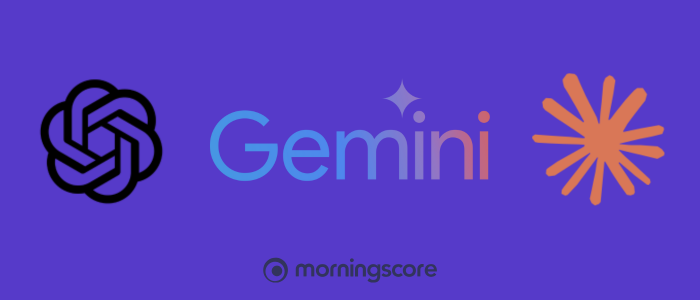
AI is playing an increasingly significant role in SEO, and the importance of this development cannot be underestimated.
One of the great benefits of using AI in SEO is its ability to understand user intent behind a search, known as “search intent.” This is valuable and can help you produce or optimize your keyword research, keyword mapping, content production, etc.
AI tools like ChatGPT can generate optimized content, find relevant keywords, and create topics that match the user’s search behavior.
But! Yes, there’s a “but”… The output you get from ChatGPT, Claude, or other AI tools is only as good as the input, context, and guidelines you provide – also known as prompts. We’ll look into prompting later, but if you want to get a head start, you can read more on how to create prompts for ChatGPT here.

ChatGPT can analyze trends and identify the questions your customers often ask, thus providing ideas for creating content that meets their needs and improves your visibility on Google for their informational or query searches.
At the same time, AI can help you analyze competitors, their content, writing style, targeted search intents, covered topics, and even assist you in updating, optimizing, and enriching outdated content to improve your content quality.
AI in SEO allows you to work smarter – not harder. It’s about optimizing your strategy so you can spend your time on the right things and create long-lasting value. Using AI for SEO not only enhances your ranking on Google but also makes your website more relevant to visitors, potentially leading to more conversions and a stronger online brand over time.
So, how can you use it practically and for which SEO tasks? Let’s dive in.
Terms worth knowing
To understand all the terms used throughout this post, here’s an explanation of concepts and abbreviations:
- AI: AI stands for Artificial Intelligence, designed to mimic or simulate aspects of human cognition. In other words, it’s an attempt to make machines think, learn, and act in ways similar to human reasoning and behavior.
- ChatGPT: ChatGPT is an advanced AI model developed by OpenAI, designed to understand and generate human-like text. It uses technology known as “transformers” and is trained on large text datasets, allowing it to answer questions, write content, assist with ideas, and more.
- Prompt/prompting: A prompt is the text or input you provide to an AI model like ChatGPT to start a conversation or get it to generate a response or action. It serves as an instruction, guiding the model on what you want it to do.
- Topic cluster: Creating clusters of content intended to cover an entire topic in depth. This is done by creating a primary page and a series of subpages, each covering specific parts of the main topic in depth, all interlinked with the main page and other relevant subpages.
- Search intent: The intent behind a user’s search. Is the user looking for information, guides, or to make a purchase? Your landing page and content should match what the user is actually searching for.
Research on topics and keywords
One of the first things ChatGPT can help you with is brainstorming relevant keywords and topics that can boost your visibility on Google.
It’s simple: You can ask ChatGPT to suggest popular topics in your industry or specific keywords that your competitors might already rank for. ChatGPT can even help you suggest synonyms and related search terms, creating more varied and natural content that captures a wider range of searches.
AI tools don’t have access to valid keyword data like our keyword research tool, but they’re excellent tools for researching keywords, topics, and generating content ideas.
You don’t necessarily need an AI tool to perform keyword analysis, content ideas, etc., but it’s a good tool when you want to save time on the otherwise tedious task of finding keywords.
Use this prompt to get suggested keywords:
Generate 10 keywords I can write a targeted blog post about in the [your industry/topic] niche.
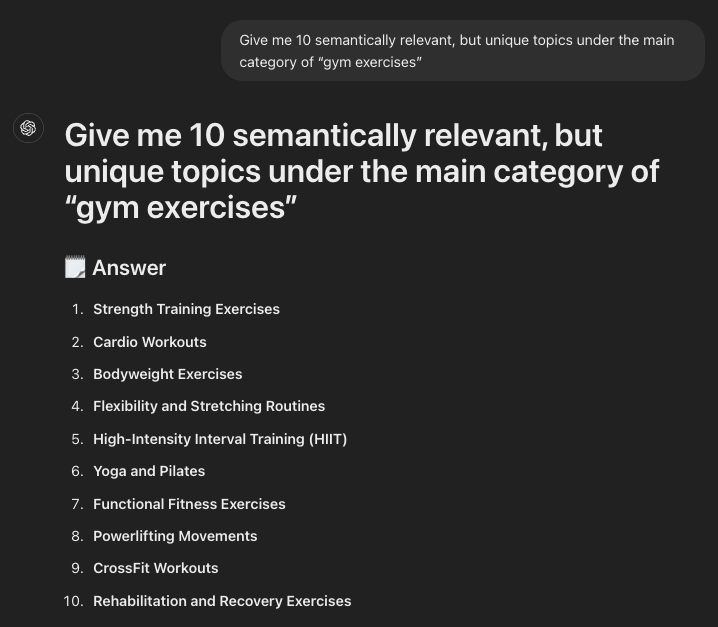
Apart from the fact that you won’t get search volume, organic rankings, and similar data, you can simply ask ChatGPT to provide you with a series of related keywords, topics, topic clusters, and so on.
Use this prompt to generate blog post topics:
Give me 10 semantically relevant but unique topics under the main category [topic/keyword].
See more prompts for keyword research here.
Use AI tools for initial SEO content
AI can’t write perfect, well-developed, and in-depth content. At least not high-quality, original content that truly provides value to the user. LLMs don’t know what they don’t know.
However, what ChatGPT is particularly good at is helping you in the writing process, avoiding “writer’s block” or the “blank page syndrome.”
Good content is the key to high rankings. ChatGPT can help you write engaging, informative content that your readers actually want to read – and stick around for.
You can use ChatGPT to generate drafts, come up with interesting angles, or write explanations that are easy to understand. At Morningscore we also have an AI writer tool ourself that you can use to create fully optimized articles that are actually ranking.
The result? Texts that engage your readers and score points with Google.
So, how can you use it?
Use ChatGPT to generate outlines, content structures, ideas for headlines, or to structure a post on a given topic.
Once you have a complete article structured with headings, it becomes much easier to tackle the task and start writing valuable content for your users, saving a lot of time in the initial phase of figuring out what your article, blog post, or landing page should include.
Use this prompt to create outlines:
I’m preparing an article titled [‘Your Page Title’]. Draft an SEO-friendly outline that structures the blog post and provides a sequential overview of topics to cover.
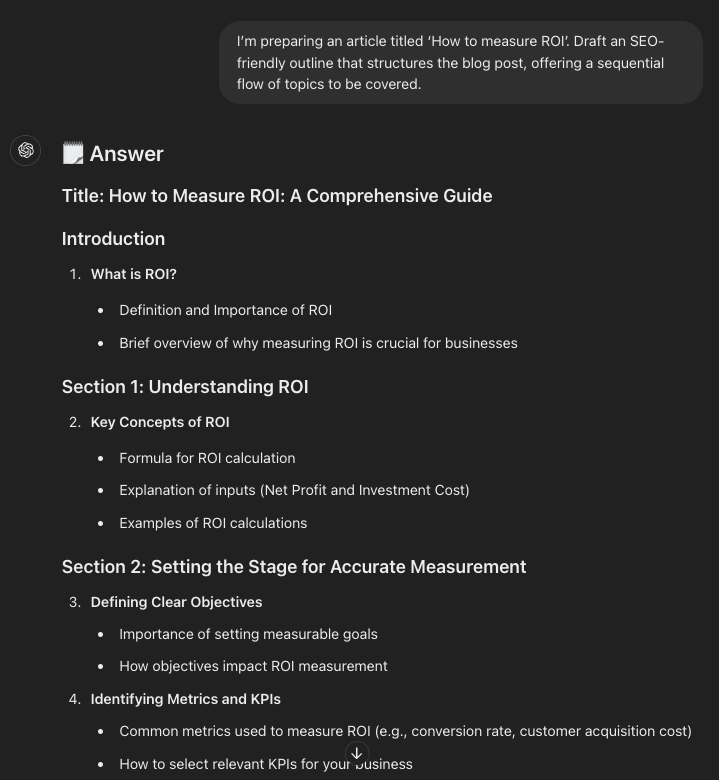
Use AI tools to suggest schema markup you can add, assist in rephrasing sentences, or provide entire sections that you can rewrite to fit your tone of voice.
Technically, ChatGPT can write a complete blog post for you, but it’s not a good idea to do so. AI tools are not known for always delivering credible output; there’s often a lot of “fluff,” generic text with no value, lacking originality, and lacking your tone of voice.
You’ll achieve a much better result if you use your AI tool to create a content outline and write the content yourself – or at least edit the content heavily if you let ChatGPT write the entire post.
As an alternative you could write the whole content yourself and throw it back into ChatGPT, give instructions on how to optimize it. For example by correcting gramma, changing the tone or making it easier for people to read or understand.
ℹ️ Good to know:
- Always review and edit text delivered by AI tools so it aligns with your tone of voice, adds value, and fits contextually with the topic.
- Always fact-check information provided by AI.
- Add personal opinions and data.
- Always convert passive phrases to active ones.
See more prompts for generating SEO content here.
Specify tone of voice for writing
Have ChatGPT write in a way and style that suits your website’s universe and your writing style.
First, it’s essential to establish a persona for ChatGPT. A persona that the AI will identify with and act from, with the characteristics of the profile/agenda.
Always start by defining a persona by writing:
You are an “experienced copywriter,” “proofreader,” “business law attorney,” etc.
Then specify the context, task description, information/data the AI can use about the topic, specify the text length, structure, and the desired writing style and tone.
Examples of writing style prompts:
- Creative
- Informal
- Academic
- Business
- Journalistic
- Scientific
Examples of tone prompts:
- Funny
- Relaxed
- Excited
- Professional
- Witty
- Sarcastic
- Feminine
- Masculine
- Bold
- Dramatic
- Grumpy
- Mysterious
Your prompt might look like this:
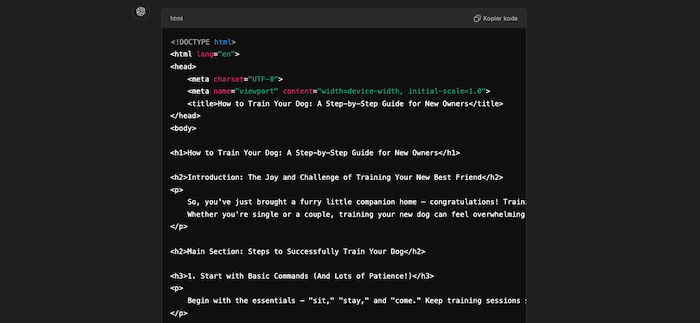
You are a skilled copywriter
Write a blog post explaining how to train a dog.
The goal is to educate singles and couples who have recently acquired a dog as a pet.
The target audience is new dog owners.
Ensure the text has an ideal length based on industry standards.
Write in Danish with an informal style and an engaging tone.
Write in the first person with direct language. Always rewrite passive sentences.
Create a compelling and catchy title in H1 format.
Format the text using HTML code and H2 subheadings: [introduction – add persuasive power words], [main section – include emotional appeal and break into sub-sections] and [conclusion – express a sense of urgency and include a CTA].
Now you have a piece of content written in a style and tone that suits your website and audience, ready for editing, rewriting, optimization, and enrichment.
Enrich your AI content with expert knowledge
What is classified as quality content can be created by both humans and AI. Human-created content can also be low quality.
If you have used ChatGPT to produce a decent piece of standard content but want to deliver high-quality content, what should you do?
You can, of course, handle it manually by editing the content with your own writing skills.
You can also use AI and the available information out there.
To enrich your AI content with original expert knowledge, you can use several methods. One of them is to use videos, podcasts, or other non-written formats.
Start by finding a podcast or video that specifically discusses the topic you’re writing about.
Download it, transcribe the entire recording with a transcription tool, upload the transcription to ChatGPT, and ask ChatGPT to enrich your content (insert your content) with knowledge from the transcription.
This way, you upgrade your existing standard AI content from standard to high quality with original expert insights.
You can use this method for all your existing content to update and improve it.
Fact-check AI-generated content
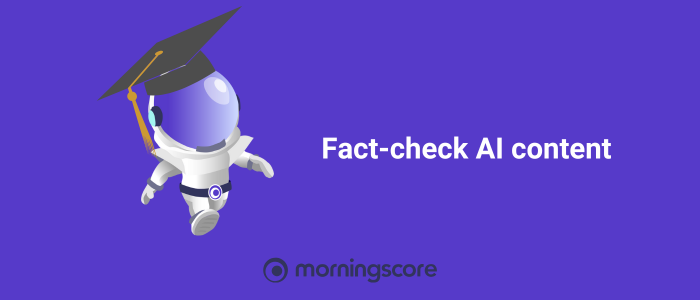
AI can make mistakes, and it often does – especially when it comes to gathering data about people, companies, and similar topics.
That’s why it’s crucial to fact-check all content before publishing it on your website.
Fact-checking an entire blog post can be time-consuming, so how can you use AI to fact-check AI-generated text?
Can AI fact-check its own content? Yes and no.
There’s a simpler and much more reliable method for fact-checking AI content.
Find one or two articles on the same topic and ask ChatGPT to fact-check the finished content against these two sources. Ask ChatGPT to highlight and show where there are factual inaccuracies so that you can correct the content.
When you do this, ChatGPT checks everything that might be incorrect against the two sources and shows you if there are any factual inaccuracies or statements that may not be outright wrong but do not fully align.
Analyze and compare your competitors’ landing pages
Want to beat your competitors on their own turf? Then you need to know what they do well and where they have weaknesses you can exploit.
By using AI tools, you can easily gain insights into what works for them and the opportunities you can capitalize on.
Start by looking at their keywords, page structure, and the CTAs (calls to action) they use. AI tools can help you gain deeper insight into their content weaknesses.
You can even reveal their SEO strategy. Use the data to adapt your own landing page and create something even more effective and relevant for your customers. And remember, it’s not about copying – it’s about learning and improving your SEO strategy.
Use this prompt to analyze your competitors’ content:
You are my SEO analyst. Analyze the content from the following URLs:
1) [URL 1] / {Content from page 1}
2) [URL 2] / {Content from page 2}
3) [URL 3] / {Content from page 3}
Get help with the “boring” SEO tasks
We all know the less exciting parts of SEO work, such as checking for text repetitions, creating word choice variations, and ensuring that the text is grammatically correct.
This is where ChatGPT can save you a lot of time and probably do better than you.
Ask ChatGPT to review your text and provide suggestions for improvements – from better word choice to smoother phrasing. This way, you can quickly make your content more professional without spending hours proofreading – or paying a high hourly rate for a proofreader.
ChatGPT vs. Claude

Primary use cases in marketing and SEO
ChatGPT
- Keyword analysis & content suggestions: Effective for keyword discovery and clustering, ideal for optimizing content for SEO.
- Content planning: Provides structured ideas and outlines for blogs, articles, and campaigns.
- Data formatting & structured output: Delivers content in JSON, HTML, or custom formats, useful for SEO analysis or data needs.
Claude
- Long-tail and conversational content: Ideal for a conversational tone in FAQ sections, support content, and engagement-oriented material.
- Content summarization: Summarizes large amounts of text and extracts key points for competitor analysis and research.
- Personalization: Adjusts tone for specific target audiences, ensuring a consistent brand voice across channels.
Functionality
| Feature | ChatGPT | Claude |
|---|---|---|
| Custom output | Produces content in various formats (JSON, HTML) for integration or technical SEO | Adjusts tone and style, suitable for target audience segmentation |
| Content structuring | Provides detailed outlines, keyword ideas, and content plans | Summarizes and condenses information for easy understanding |
| API & integration | OpenAI’s API supports automation, data processing, and content generation | API enables real-time customization, ideal for interactive content |
| Prompt flexibility | Handles complex prompts for SEO or content needs | Intuitive interaction, quick tone adjustments |
| SEO & marketing-specific tools | Supports keyword clusters, topic clusters, and data-driven content | Great for FAQs, long-tail keywords, and customer-focused text |
Pricing structure and availability
| Plan | ChatGPT | Claude |
|---|---|---|
| Free plan | GPT-3.5 available at no cost with limited features | Free version for basic content generation |
| Paid options | GPT-4 via ChatGPT Plus at $20/month | Various subscription options starting at $20/month |
| API access | Available for external integrations | API available, pricing depends on volume and usage |
User experience and usability
| Aspect | ChatGPT | Claude |
|---|---|---|
| Learning curve | Some prompt understanding optimizes results | User-friendly, good for simple content needs |
| Interaction style | Flexible with structured prompts for detailed content | Conversational, ideal for customer support |
| Support and community | Large community, easy access to examples | Growing community forums, especially in conversational AI |
Should you choose ChatGPT or Claude?
Both ChatGPT and Claude are effective tools for various marketing and SEO tasks, data analysis, and automation.
Ultimately, it depends on your needs and which tool you find easiest to work with. Try both tools to see which one suits you best.
FAQ
Do you need to be an expert to use AI in SEO?
AI tools are increasingly available to beginners and small businesses that don’t have specialists on staff.
Many affordable AI solutions make it possible to leverage SEO without extensive technical knowledge, allowing even smaller businesses to improve their site performance and organic rankings with AI tools.
AI assists with keyword analysis, topic clusters, keyword mapping, and SEO-friendly text, enabling businesses to boost visibility without needing an SEO expert.
However, AI tools don’t deliver better results than the task you set up. The real difference lies in how beginners and AI-savvy prompt engineers approach prompting.
Being able to prompt in a precise way that makes AI tools deliver high-quality output requires you to dive into the subject and spend time learning to use it, just like learning anything else.
How do you implement AI in SEO?
Implementing AI in SEO requires a hybrid approach where human insight still plays an essential role. AI can dynamically update content based on changing user needs and suggest adjustments to keep content relevant.
How does AI help with keyword analysis?
AI improves keyword analysis by identifying user intent and sorting relevant keywords – much faster than you and I can.
AI can also group user questions into themes like “what,” “when,” and “how,” which helps target keywords to meet audience needs.
What role does AI play in content optimization?
AI optimizes content using natural language processing (NLP), analyzing competitors’ content to ensure articles cover topics that others overlook.
Google’s algorithms aren’t opposed to AI-created content. In fact, they have updated their guidelines, removing the requirement for content to be “created by humans for humans.”
In other words, Google doesn’t care if it’s me, you, or an AI model writing the content on a website. The only thing that matters is that the content is useful and created FOR humans.
Always edit AI-created content to add firsthand experience with the subject and your specific expertise to demonstrate EEAT (Experience, Expertise, Authoritativeness, Trustworthiness).
Definition of NLP: NLP helps AI understand and generate human language, which is central to AI-based content optimization.
Does Google penalize AI-generated content?
AI detects publication frequency and content depth, which helps Google identify and flag sites that flood the internet with low-quality content.
It’s not about being penalized for publishing AI content or new landing pages; it’s about quality and moderation (avoid publishing 1,000 blog posts a day if that’s not your usual practice).
If Google suddenly sees you publishing hundreds of articles daily, they’ll question how you achieved it.
Are you penalized for publishing AI-created content? No, you’re not.
Are you penalized for publishing 1,000 new landing pages? No, not because of the sheer number, but if they contain low-quality content, it’s an issue regardless of whether you publish 10 or 1,000 pages.
How can AI help with competitor analysis?
AI analyzes competitors’ content, backlinks, writing style, content structure, and more. Just provide ChatGPT with data you have available (or simply a competitor’s URL) and ask it to analyze what you want examined.
This could include semantic words they use, frequency, tone of voice, link sources, and their pricing (highest, lowest, average).
Can AI be used for link building?
My personal opinion is that it can’t. Technically, you can use ChatGPT and other AI tools to analyze and identify link-building opportunities, but my experience is that AI for link building is not yet a viable method.
Link building requires manual work to succeed, but you can use some prompts to streamline the workflow and automate tasks that don’t necessarily require manual input. However, going from no link to seeing it appear in a backlink checker cannot be achieved solely with AI.
If you still want to give it a try, we’ve compiled a list of prompts for link building here.
How can small businesses use AI for SEO on a limited budget?
Small businesses can combine Google’s auto-suggest with AI as an affordable way to conduct keyword research and content optimization. Using ChatGPT, which is available in a free version, even businesses with limited resources can achieve targeted SEO results without significant expenses.
AI provides access to precise analyses that were previously available only to larger companies, making the technology accessible to everyone.
How can AI make SEO content more human-centered?
AI can enhance pre-written content, making it easier to read and understand. For example, AI can add clear summaries and tailor content to specific audiences, increasing the time readers spend on the page and providing a better user experience. This improves SEO and meets search engines’ demands for relevant and engaging content.
Provide ChatGPT, Claude, or any AI tool with explicit instructions on how content should be generated for a human-centered feel. Specify role, tone, language, and, if possible, link to your published content so it understands your writing style and can replicate it accurately.
How can I track brand mentions in ChatGPT?
Tracking when and how your brand is mentioned in ChatGPT is super easy. You just need a Morningscore account to access the ChatGPT citation tracker and put in the terms and prompts you want to track.

